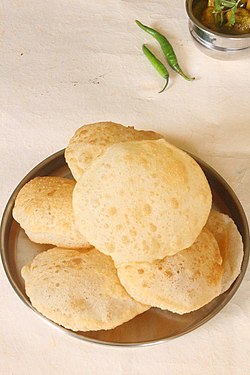Puri (food)
South Asian deep-fried bread From Wikipedia, the free encyclopedia
Puri, also poori, is a type of deep-fried bread, made from unleavened whole-wheat flour, originated from the Indian subcontinent.
 Puri on a plate | |
| Place of origin | Indian subcontinent |
|---|---|
| Region or state | Indian subcontinent, Southeast Asia, Caribbean |
| Associated cuisine | India, Bangladesh, Pakistan, Nepal, Malaysia, Myanmar, Singapore, Sri Lanka, Mauritius, Trinidad and Tobago, Guyana |
| Serving temperature | Hot or cold |
| Main ingredients | Atta |
| Variations | Bhatoora, Luchi, Sevpuri, Panipuri |
Puris are most commonly served as breakfast or snacks. It is also served at special or ceremonial functions as part of ceremonial rituals along with other vegetarian food offered in Hindu prayer as prasadam. When hosting guests it is common in some households to serve puri in place of roti, as a small gesture of formality. Puri is often eaten in place of roti on special holidays.
Name
The name Puri derives from the Sanskrit word पूरिका (pūrikā), from पूर (pūra) "filled".[1] In other South Asian languages it is known as: Urdu: پوری (pūrī), Dogri and Hindi: पूरी (pūrī) or पूड़ी (pūṛī), Kumaoni: लगड (lagaḍ), Tamil: பூரி (poori), Telugu: పూరి (pūri), Gujarati: પૂરી, Assamese: পুৰি (puri), Bengali: পুরি (pūri), Bhojpuri: पूड़ी (pūṛī), Marathi: पूरी (pūrī), Kannada: ಪೂರಿ (pūri), Malayalam: പൂരി (pūrī), Burmese: ပူရီ (pūrī), Nepali: पूरी (puri), Odia: ପୁରି (puri), Punjabi: ਪੂਰੀ (pūṛī), Garhwali: पूरी (pūrī), [2]
Ingredients
Puris are prepared with wheat flour, either atta (whole wheat flour) or sooji (coarse wheat flour). In some recipes, ajwain, cumin seed, spinach, or fenugreek seeds are added to the dough. The dough is either rolled out in a small circle or rolled out and cut out in small circles, then deep fried in ghee or vegetable oil. While deep frying, puris puff up like a round ball because moisture in the dough changes into steam which expands in all directions. They are flipped once in the frying process, and when they are golden-brown in color, they are removed and either served hot or saved for later use (as with the snack food pani puri). Rolled puris may be pricked with a fork before deep frying to make flat puris for chaat like bhel puri. A punctured puri does not puff when cooked because the steam escapes as it cooks. Masala puri adds turmeric, chili powder, coriander and cumin, and hing (asafoetida) to the dough.
Types and variants
Summarize
Perspective
A variant of the puri popular in the eastern part of Indian subcontinent is Luchi (in West Bengal and Odisha) or lusi in Assam, luchui[3] and Jharkhand. Luchi is made using refined wheat flour (samidh flour) and is deep fried. It is served with typical side dishes like aloor dum (potato preparation), Chana ghugni, begun bhaja (fried eggplant) and others.
Another variant, largely popular in the Braj culinary tradition of the Northern Indian state of Uttar Pradesh is bedmi puri or bedai.[4] It is prepared using stuffing of Urad dal paste and paired with Mathura's Dubki Aloo jhor.[5]
A variant of puri is bhatoora, which is three times the size of a puri and served with chholey (spicy chickpeas). It often constitutes a full meal. (See chole bhature.) Bhatoora is made with yeast and yogurt in the dough and puri is made from unleavened dough.[6]
In the Indian state of Odisha a large-sized puri is made during Bali Yatra which is called thunka puri (Odia: ଠୁଙ୍କା ପୁରି).[7][8][9][10][11]
The puris used for panipuri are smaller, and are usually made crisper by the addition of rava/sooji (semolina) to the dough.
Sev puri is an Indian snack offered by street vendors who serve chaat.
Street vendors in Mumbai serve bhel in a throw-away folded leaf with a flat puri to scoop it.
Fast food chains in the Middle East use puri for fried chicken wraps.
Gallery
- Puri Bhajji in Mumbai restaurant, served with potato curry and coriander leaf chutney
- Aloo puri, a typical morning snack in Varanasi, India
- Puri frying in Pakistan
- Poori or Puri, traditionally deep fried from most Indian restaurants
- Dal puri, a traditional Bengali version
- Mini-puris are part of a panipuri snack. It is crunchier in texture.
- Daal puri, Bangladesh
- Thin bread is fried in oil and eaten with a salty curry of chickpeas, potatoes and sweet pudding.
- Puri, made of wheat flour, which is used in panipuri
- Puri, made of rawa, which is used in panipuri
See also
References
External links
Wikiwand - on
Seamless Wikipedia browsing. On steroids.










